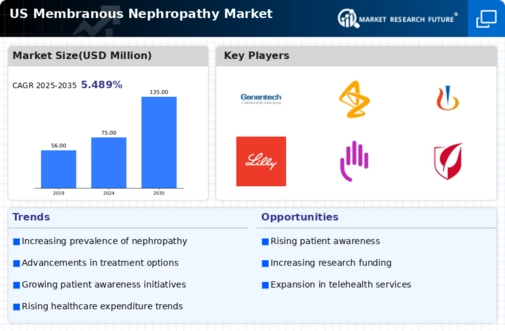The US Membranous Nephropathy Market has emerged as a significant space in the healthcare landscape, driven by increasing awareness and the growing incidence of kidney-related disorders. Membranous nephropathy is characterized by the thickening of the membranous glomerular structure, and its treatment landscape is evolving with the introduction of novel therapies aimed at improving outcomes for patients. This market is characterized by a combination of established players and emerging biotechnology firms, all vying to capture market share through innovative solutions.
Competitive dynamics are shaped by factors such as product efficacy, safety profiles, regulatory approvals, and the ability to effectively engage healthcare providers. Additionally, the collaboration between pharmaceutical companies and research institutions has intensified, leading to a more rapid development of therapies tailored to the unique challenges posed by membranous nephropathy.
In the context of the US Membranous Nephropathy Market, Genentech stands out due to its robust pipeline and commitment to research and development. The company's strengths lie in its history of innovation and a clear focus on biologics that address autoimmune disorders and kidney diseases. Genentech's expertise in monoclonal antibodies positions it favorably in the treatment landscape, allowing it to leverage its advanced capabilities in targeted therapy development. Moreover, Genentech's strong brand presence and established distribution networks enhance its competitiveness.
The company's collaborations with academic institutions and participation in clinical trials further bolster its reputation, while its engagement in patient advocacy initiatives enhances awareness and support for membranous nephropathy, making it an influential player in the market.
AstraZeneca's presence in the US Membranous Nephropathy Market is also noteworthy, given its focus on developing targeted therapies that align with unmet medical needs. The company boasts a range of key products that cater to diverse patient populations, leveraging its expansive research capabilities to drive advancements in treatment options. AstraZeneca is known for its strategic mergers and acquisitions, which have enriched its portfolio and bolstered its position within the nephrology space. With a strong emphasis on data-driven approaches and real-world evidence generation, AstraZeneca has effectively positioned itself as a reliable partner for healthcare providers.
Moreover, its commitment to sustainability and community health initiatives enhances its visibility and connects it more deeply with patients and caregivers in the US, allowing AstraZeneca to maintain a competitive edge in this evolving market.
























